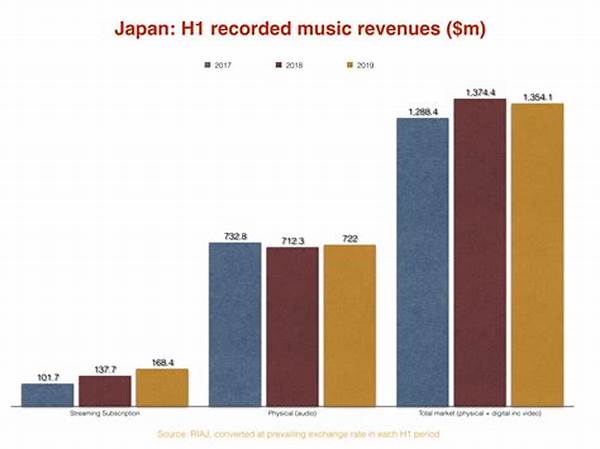Japanese music is breaking the mold, shattering boundaries, and carving out its unique place in Western markets. Imagine the vibrant, eclectic rhythms and harmonious melodies transforming the global soundscape as you read this. There’s no denying it—Japanese music is not just knocking on the door of Western markets; it’s kicking it wide open. In a world increasingly connected by digital streams and shared playlists, this cross-cultural exchange is as natural as grabbing your favorite snack from the fridge. Much like sushi’s global takeover, Japanese tunes now add their flavor to the Western musical smorgasbord. So, what makes Japanese music such an irresistible force in Western markets?
Read Now : Relaxing Songs Popular For Study Time
The Allure of Beats: Why Japanese Music Clicks
It’s 2023, and Japanese music in Western markets is the hot topic on everyone’s lips. But what gives it that extra ‘oomph’? For starters, Japanese music brings something fresh to the table, fusing Western influences with traditional Japanese sounds. From J-pop’s bubbly exuberance to J-rock’s edgy vibe, it’s a musical feast that caters to everyone’s taste. And let’s not forget the anime soundtracks—these are the secret sauce that leaves Western fans craving for more. The online fan communities also play a pivotal role, hyping up releases and dissecting every beat and lyric. In essence, Japanese music offers a full-package deal, complete with unique cultural additives that make it stand out in Western markets.
From Sushi to Soundwaves: The Journey
Ever notice how Japanese music in Western markets is like a cultural tidal wave? Firstly, J-pop bands such as Nogizaka46 and Arashi have risen from being local favorites to enjoying global stardom, filling arenas in countries miles away from Japan. Secondly, collaborations between Western and Japanese artists have yielded fresh, groundbreaking tracks. Think of it as musical fusion cuisine! Thirdly, social media has provided a worldwide stage, making it simple for fans overseas to discover this unique sound without ever leaving their home. All these factors combined provide a recipe for success that is hard to resist in Western music markets.
The Influence of Digital Platforms
Digital platforms have played a massive role in saturating Western markets with Japanese music. Streaming services like Spotify and Apple Music offer ever-expanding playlists featuring Japanese tracks that grab new ears daily. Online forums and fan sites buzz with discussions, reviews, and deep dives into album details, slowly converting curious listeners into die-hard aficionados. Digital access has made Japanese music not just a curiosity but a staple for Western audiences eager for something beyond the mainstream. As more and more listeners plunge into these new rhythms, the adaptability and innovation of Japanese sounds find an ever-growing audience in Western music markets.
Unraveling Language Barriers
So, how does Japanese music capture hearts across linguistic divides? First, music is a universal language, communicating emotions that transcend words. Second, Japanese music creators aren’t afraid to experiment with English lyrics or even fuse languages within the same track. Add this to catchy hooks and captivating melodies, and you’ve got a winning formula. Contextual understanding, rather than word-for-word appreciation, allows Western fans to vibe with the rhythm. Plus, many fans go the extra mile, learning Japanese phrases, enriching their music experience, and deepening their cultural appreciation in the process. Effortlessly, Japanese music in Western markets has become more than just a trend—it’s a bridge connecting disparate worlds.
Read Now : Global Spread Of Cumbia Fusion
The Role of Anime Culture and Soundtracks
If there’s a Trojan horse smuggling Japanese music into Western hearts, it’s anime. Anime series often bring captivating soundtracks that immediately resonate with Western fans. The infectious beats and compelling narratives keep audiences hooked, and conversely, they seek out the artists behind these epic songs. The power of visuals fused with audio creates an immersive experience that hooks you before you even realize it. Fan communities thrive on dissecting these elements, and in no time, soundtracks become gateway drags leading to more Japanese music genres. Without a doubt, anime soundtracks have become one of the driving forces behind the success of Japanese music in Western markets.
A Sonic and Cultural Revolution
It’s more than just beats and melodies; it’s a cultural exchange. When we think of Japanese music in Western markets, we’re looking at a revolution, y’all. This isn’t simply about listening to music; it’s embracing cultural nuances, learning about new traditions, and celebrating a world full of diversity. It’s about stepping out of comfort zones and growing more open-minded in our musical selections. This cultural revolution might have been sparked by music, but it’s igniting a broader, more inclusive understanding of the global community. More than ever, Japanese music in Western markets signifies a fusion of thoughts and cultures, resonating with adventurous fans ready to embrace what the world has to offer.
